Spatio-Temporal Variations of Rain-Use Efficiency in the West of Songliao Plain, China
Abstract
:1. Introduction
2. Materials and Methods
2.1. Study Area
2.2. Data Collection and Processing
2.3. Methods
2.3.1. Calculation of RUE
2.3.2. Determination of the Trends in RUE Change
2.3.3. Grey Correlation Analysis
3. Results
3.1. RUE Changes
3.1.1. Spatial Pattern
3.1.2. Interannual Changes
3.1.3. Change Trend
3.2. RUE Variations in Response to Land Use/Cover Changes
3.3. The Main Causes of RUE Changes
3.3.1. Climate Variations
3.3.2. Socio-Economic Development
3.3.3. The Influential Determinants of RUE Change
4. Discussion
4.1. Characteristics of RUE Variations
4.2. Spatial Pattern of Climate, Human Activities Impacts on RUE
5. Conclusions
Acknowledgments
Author Contributions
Conflicts of Interest
References
- An, N.; Price, K.P.; Blair, J.M. Estimating above-ground net primary productivity of the tallgrass prairie ecosystem of the Central Great Plains using AVHRR NDVI. Int. J. Remote Sens. 2013, 34, 3717–3735. [Google Scholar] [CrossRef]
- Buyantuyev, A.; Wu, J. Urbanization alters spatiotemporal patterns of ecosystem primary production: A case study of the Phoenix metropolitan region, USA. J. Arid Environ. 2009, 73, 512–520. [Google Scholar] [CrossRef]
- Le Houèrou, H.N. Rain use efficiency: Unifying concept in arid-land ecology. J. Arid Environ. 1984, 7, 213–247. [Google Scholar]
- Fensholt, R.; Rasmussen, K. Analysis of trends in the Sahelian “rain-use efficiency” using GIMMS NDVI, RFE and GPCP rainfall data. Remote Sens. Environ. 2011, 115, 438–451. [Google Scholar] [CrossRef]
- Hein, L.; Ridder, D.E. Desertification in the Sahel: A reinterpretation. Glob. Chang. Biol. 2006, 12, 751–758. [Google Scholar] [CrossRef]
- Verón, S.R.; Paruelo, J.M.; Oesterheld, M. Assessing desertification. J. Arid Environ. 2006, 66, 751–763. [Google Scholar] [CrossRef]
- Snyman, H.A.; Fouché, H.J. Production and water-use efficiency of semi-arid grasslands of South Africa as affected by veld condition and rainfall. Water S. Afr. 1991, 17, 263–268. [Google Scholar]
- Nicholson, S.E.; Tucker, C.J.; Ba, M.B. Desertification, drought, and surface vegetation: An example from the West African Sahel. Bull. Am. Meteorol. Soc. 1998, 79, 815–829. [Google Scholar] [CrossRef]
- Prince, S.D.; de Colstoun, E.B.; Kravitz, L.L. Evidence from rain use efficiencies does not support extensive Sahelian desertification. Glob. Chang. Biol. 1998, 4, 359–374. [Google Scholar] [CrossRef]
- Wessels, K.J.; Prince, S.D.; Malherbe, J.; Small, J.; Frost, P.E.; VanZyl, D. Can human-induced land degradation be distinguished from the effects of rainfall variability? A case study in South Africa. J. Arid Environ. 2007, 68, 271–297. [Google Scholar] [CrossRef]
- Huxman, T.E.; Smith, M.D.; Fay, P.A.; Knapp, A.K.; Shaw, M.R.; Loik, M.E.; Smith, S.D.; Tissue, D.T.; Zak, J.C.; Weltzin, J.F.; et al. Convergence across biomes to a common rain-use efficiency. Nature 2004, 429, 651–654. [Google Scholar] [CrossRef] [PubMed]
- Bai, Y.F.; Wu, J.G.; Xing, Q.; Pan, Q.M.; Huang, J.H.; Yang, D.L.; Han, X.G. Primary production and rain use efficiency across a precipitation gradient on the Mongolia Plateau. Ecology 2008, 89, 2140–2153. [Google Scholar] [CrossRef] [PubMed]
- Hu, Z.M.; Yu, G.R.; Fan, J.W.; Zhong, H.P.; Wang, S.Q.; Li, S.G. Precipitation-use efficiency along a 4500-km grassland transect. Glob. Ecol. Biogeogr. 2010, 19, 842–851. [Google Scholar]
- Li, H.X.; Liu, G.H.; Fu, B.J. Spatial variations of rain-use efficiency along a climate gradient on the Tibetan Plateau: A satellite-based analysis. Int. J. Remote Sens. 2013, 34, 7487–7503. [Google Scholar] [CrossRef]
- Diouf, A.; Lambin, E.F. Monitoring landcover change in semi arid regions: Remote sensing data and field observati on in Ferlo, Senegal. J. Arid Environ. 2001, 48, 129–148. [Google Scholar] [CrossRef]
- Symeonakis, E.; Drake, N. Monitoring desertification and land degradation over sub-Saharan Africa. Int. J. Remote Sens. 2004, 25, 573–592. [Google Scholar] [CrossRef]
- Prince, S.D.; Wessels, K.J.; Tucker, C.J.; Nicholson, S.E. Desertification in the Sahel: A reinterpretation of a reinterpretation. Glob. Chang. Biol. 2007, 13, 1308–1313. [Google Scholar] [CrossRef]
- Bai, Z.G.; Dent, D.L.; Olsson, L.; et al. Proxy global assessment of land degradation. Soil Use Manag. 2008, 24, 223–234. [Google Scholar] [CrossRef]
- Del Borrio, G.; Puigdefabregas, J.; Sanjuan, M.E.; Stellmes, M.; Ruiz, A. Assessment and monitoring of land condition in the Iberian Peninsula, 1989–2000. Remote Sens. Environ. 2010, 114, 1817–1832. [Google Scholar] [CrossRef]
- Hein, L.; de Ridder, N.; Hiernaux, P.; Leemans, R.; de Wit, A.; Schaepman, M. Desertification in the Sahel: Towards better accounting for ecosystem dynamics in the interpretation of remote sensing images. J. Arid Environ. 2011, 75, 1164–1172. [Google Scholar] [CrossRef]
- Fensholt, R.; Rasmussen, K.; Kaspersen, P.; Swinnen, E. Assessing land degradation/recovery in the African Sahel from long-term earth observation based primary productivity and precipitation relationships. Remote Sens. 2013, 5, 664–686. [Google Scholar] [CrossRef]
- Dardel, C.; Kergoat, L.; Hiernaux, P.; Grippa, M.; Mougin, E.; Ciais, P.; Nguyen, C. Rain-Use-Efficiency: What it Tells us about the Conflicting Sahel Greening and Sahelian Paradox. Remote Sens. 2014, 6, 3446–3474. [Google Scholar] [CrossRef]
- Xu, X.; Sherry, R.A.; Niu, S.L.; Li, D.J.; Luo, Y.Q. Net primary productivity and rain-use efficiency as affected by warming, altered precipitation, and clipping in a mixed-grass prairie. Glob. Chang. Biol. 2013, 19, 2753–2764. [Google Scholar] [CrossRef] [PubMed]
- Paruelo, J.M.; Lauenroth, W.K.; Burke, I.C.; et al. Grassland precipitation-use efficiency varies across a resource gradient. Ecosystems 1999, 2, 64–68. [Google Scholar] [CrossRef]
- Li, H.X.; Wei, X.H.; Zhou, H.Y. Rain-use efficiency and NDVI-based assessment of karst ecosystem degradation or recovery: A case study in Guangxi, China. Environ. Earth Sci. 2015, 74, 977–984. [Google Scholar] [CrossRef]
- Zhang, G.L.; Dong, J.W.; Xiao, X.M.; Hua, Z.M.; Sheldon, S. Effectiveness of ecological restoration projects in Horqin Sandy Land, China based on SPOT-VGT NDVI data. Ecol. Eng. 2012, 38, 20–29. [Google Scholar] [CrossRef]
- Li, A.M.; Han, Z.W.; Xu, J.; Ma, S.X.; Huang, C.H. Transformation dynamics of desertification in Horqin Sandy Land at the beginning of 21st Century. Acta Geogr. Sin. 2006, 61, 976–984. [Google Scholar]
- Du, Z.T.; Zhan, Y.L.; Wang, C.Y.; Song, G.Z. The dynamic monitoring of desertification in Horqin Sandy Land on the basis of MODIS NDVI. Remote Sens. Land Resour. 2009, 20, 14–18. [Google Scholar]
- Peng, F.; Wang, T.; Xue, X. Study of human impact on vegetation in desertified regions based on rainfall use efficiency-A case study of Horqin region, Inner Mongolia. J. Desert Res. 2010, 30, 896–902. [Google Scholar]
- Yin, H.; Li, Z.G.; Wang, Y.L.; Cai, F. Assessment of desertification using time series analysis of hyper-temporal vegetation indicator in Inner Mongolia. Acta Geogr. Sin. 2011, 66, 653–661. [Google Scholar]
- An, N.; Wei, X.; Luan, J.; Fu, Y.L. Analysis of the dynamic characteristics of groundwater for recently ten years in Chifeng urban area. Inn. Mong. Agric. Sci. Technol. 2015, 43, 120–122. [Google Scholar]
- Zhao, H.L.; Zhou, R.L.; Su, Y.Z.; Zhang, H.; Zhao, L.Y.; Drake, S. Shrub facilitation of desert land restoration in the Horqin Sand Land of Inner Mongolia. Ecol. Eng. 2007, 31, 1–8. [Google Scholar] [CrossRef]
- Stokes, A.; Sotir, R.; Chen, W.; Chestem, M. Soil bio- and eco-engineering in China: Past experience and future priorities preface. Ecol. Eng. 2010, 36, 247–257. [Google Scholar] [CrossRef]
- Gobron, N.; Pinty, B.; Verstraete, M.M.; Widlowski, J.L. Advanced vegetation indices optimized for upcoming sensors: Design, performance and applications. IEEE Trans. Geosci. Remote Sens. 2000, 38, 2489–2505. [Google Scholar]
- Liu, S.L.; Wang, T.; Guo, J.; Qu, J.J.; An, P.J. Vegetation change based on SPOT-VGT data from 1998 to 2007, northern China. Environ. Earth Sci. 2010, 60, 1459–1466. [Google Scholar] [CrossRef]
- Telesca, L.; Lasaponara, R.; Lanorte, A. Intra-annual dynamical persistent mechanisms in mediterranean ecosystems revealed SPOT-VEGETATION time series. Ecol. Complex. 2008, 5, 151–156. [Google Scholar] [CrossRef]
- Huang, F.; Wang, P. Vegetation change of ecotone in west of Northeast China Plain using time-series remote sensing Data. Chin. Geogr. Sci. 2010, 20, 167–175. [Google Scholar] [CrossRef]
- Amri, R.; Zribi, M.; Lili-Chabaane, Z.; Duchemin, B.; Gruhier, C.; Chehbouni, A. Analysis of vegetation behavior in a North African semi-arid region, using SPOT-VEGETATION NDVI data. Remote Sens. 2011, 3, 2568–2590. [Google Scholar] [CrossRef]
- VITO. Product Distribution Portal. Available online: http://www.vito-eodata.be/ (accessed on 21 June 2015).
- National Meteorological Information Center of China. Available online: http://data.cma.cn (accessed on 21 June 2015).
- NASA's Earth Observing System Data and Information System. Available online: http://reverb.echo.nasa.gov/reverb/ (accessed on 21 June 2015).
- Global Land Cover Characteristics Data Base Version 2.0. Available online: http://edc2.usgs.gov/glcc/globdoc2_0.php (accessed on 21 June 2015).
- Jilin Provincial Bureau of Statistics. Jilin Statistical Book; China Statistical Press: Beijing, China, 2000–2012.
- Statistics Bureau of Inner Mongolia Autonomous Region. Inner Mongolia Statistical Book; China Statistical Press: Beijing, China, 2000–2012.
- Tucker, C.J.; Justice, C.O.; Prince, S.D. Monitoring the grasslands of the Sahel 1984–1985. Int. J. Remote Sens. 1986, 7, 1571–1582. [Google Scholar] [CrossRef]
- Justice, C.O.; Eck, T.; Tanre, D.; Holben, B. The effect of water vapor on the normalized difference vegetation index derived for the Sahelian Region from NOAA AVHRR data. Int. J. Remote Sens. 1991, 12, 1165–1188. [Google Scholar] [CrossRef]
- Pickup, G. Estimating the effects of land degradation and rainfall variation on productivity in rangelands: An approach using remote sensing and models of grazing and herbage dynamics. J. Appl. Ecol. 1996, 33, 819–832. [Google Scholar] [CrossRef]
- Holm, A.M.; Cridland, S.W.; Roderick, M.L. The use of time-integrated NOAA NDVI data and rainfall to assess landscape degradation in the arid shrubland of Western Australia. Remote Sens. Environ. 2003, 85, 145–158. [Google Scholar] [CrossRef]
- Prince, S.D.; Tucker, C.J. Satellite remote sensing of rangelands in Botswana II: NOAA AVHRR and herbaceous vegetation. Int. J. Remote Sens. 1986, 7, 1555–1570. [Google Scholar] [CrossRef]
- Prince, S.D.; Justice, C.O. Coarse resolution remote sensing in the Sahelian environment. Int. J. Remote Sens. 1991, 12, 1133–1421. [Google Scholar]
- Wessels, K.J.; Prince, S.D.; Zambatis, N.; MacFadyen, S.; Frost, P.E.; Van Zyl, D. Relationship between herbaceous biomass and 1-km2 Advanced Very High Resolution Radiometer (AVHRR) NDVI in Kruger National Park, South Africa. Int. J. Remote Sens. 2006, 27, 951–973. [Google Scholar] [CrossRef]
- Tucker, C.J.; Vanpraet, C.; Boerwinkel, E.; Gaston, A. Satellite remote-sensing of total dry-matter production in the Senegalese Sahel. Remote Sens. Environ. 1983, 13, 461–474. [Google Scholar] [CrossRef]
- Paruelo, J.M.; Epstein, H.E.; Lauenroth, W.K.; Burke, I.C. ANPP estimates from NDVI for the central grassland region of the United States. Ecology 1997, 78, 953–958. [Google Scholar] [CrossRef]
- Rasmussen, M.S. Developing simple, operational, consistent NDVI-vegetation models by applying environmental and climatic information: Part I. Assessment of net primary production. Int. J .Remote Sens. 1998, 19, 97–117. [Google Scholar] [CrossRef]
- Hope, A.; Boynton, W.; Stow, D.; Douglas, D.C. Inter-annual growth dynamics of vegetation in the Kuparuk River watershed based on the normalized difference vegetation index. Int. J. Remote Sens. 2003, 24, 3413–3425. [Google Scholar] [CrossRef]
- Ma, M.G.; Frank, V. Interannual variability of vegetation cover in the Chinese Heihe River Basin and its relation to meteorological parameters. Int. J. Remote Sens. 2006, 27, 3473–3486. [Google Scholar] [CrossRef]
- Deng, J.L. The control problems of grey system. Syst. Control Lett. 1982, 1, 288–294. [Google Scholar]
- Deng, J.L. Introduction to Grey System Theory. J. Grey Syst. 1989, 1, 1–24. [Google Scholar]
- Fu, C.; Zheng, J.; Zhao, J.; Xu, W. Application of grey relational analysis for corrosion failure of oil tubes. Corros. Sci. 2001, 43, 881–889. [Google Scholar] [CrossRef]
- Sallehuddin, R.; Shamsuddin, S.M.; Hashim, S.Z.M. Hybridization model of linear and nonlinear time series data for forecasting. In Proceedings of the Second Asia International Conference on Modeling & Simulation, Kuala Lumpur, Malaysia, 13–15 May 2008; pp. 597–602.
- Lin, S.T.; Horng, S.J.; Lee, B.H.; Khan, M.K. Application of Grey-Relational Analysis to Find the Most Suitable Watermarking Scheme. Int. J. Innov. Comput. Inf. Control 2011, 7, 5389–5401. [Google Scholar]
- Tan, X.R.; Li, Y.G. Using grey relational analysis to analyze the medical data. Kybernetes 2004, 33, 355–362. [Google Scholar]
- Song, Q.; Shepperd, M. Predicting software project effort: A grey relational analysis based method. Expert Syst. Appl. 2011, 38, 7302–7316. [Google Scholar] [CrossRef]
- Deng, J.L. Properties of relational space for grey systems. In Grey Systems; China Ocean Press: Beijing, China, 1988; pp. 1–13. [Google Scholar]
- Huang, L.; Xiao, T.; Zhao, Z.P.; Sun, C.Y.; Liu, J.Y.; Shao, Q.Q.; Fan, J.W.; Wang, J.B. Effects of grassland restoration programs on ecosystems in arid and semiarid China. J. Environ Manag. 2013, 117, 268–275. [Google Scholar] [CrossRef] [PubMed]
- Li, X.Y.; Song, K.S.; Zhang, B.; Liu, D.W.; Guo, Z.X. Assessment for salinized wasteland expansion and land use change using GIS and remote sensing in the west part of Northeast China. Environ. Monit. Assess. 2007, 131, 421–437. [Google Scholar] [CrossRef] [PubMed]
- Gao, J.; Liu, Y.S.; Chen, Y.F. Land cover changes during agrarian restructuring in Northeast China. Appl. Geogr. 2006, 26, 312–322. [Google Scholar] [CrossRef]
- Mu, S.J.; Zhou, K.X.; Qi, Y.; Chen, Y.Z.; Fang, Y.; Zhu, C. Spatio-temporal patterns of precipitation-use efficiency of vegetation and their controlling factors in Inner Mongolia. Chin. J. Plant Ecol. 2014, 38, 2–16. [Google Scholar]
- Wang, J.; Li, B.L.; Yu, W.L. Analysis of vegetation trend and their causes during recent 30 years in Inner Mongolia Autonomous Region. J. Arid Land Resour. Environ. 2012, 26, 132–137. [Google Scholar]
- Mu, S.J.; Li, J.L.; Chen, Y.Z.; Gang, C.C.; Zhou, W.; Ju, W.M. Spatial Differences of Variations of Vegetation Coverage in Inner Mongolia during 2001–2010. Acta Geogr. Sin. 2012, 67, 1255–1268. [Google Scholar]
- Zhang, Q.Y.; Zhao, D.S.; Wu, S.H.; Dai, E.F. Research on Vegetation Changes and Influence Factors Based on Eco-geographical Regions of Inner Mongolia. Sci. Geogr. Sin. 2013, 33, 594–601. [Google Scholar]
- Tucker, C.J.; Slayback, D.A.; Pinzon, J.E.; Los, S.O.; Myneni, R.B.; Taylor, M.G. Higher northern latitude normalized difference vegetation index and growing season trends from 1982 to 1999. Int. J. Biometeorol. 2001, 45, 184–190. [Google Scholar] [CrossRef] [PubMed]
- Yu, F.F.; Price, K.P.; Ellis, J.; Shi, P.J. Response of seasonal vegetation development to climatic variations in eastern central Asia. Remote Sens. Environ. 2003, 87, 42–54. [Google Scholar] [CrossRef]
- Ye, H.; Wang, J.B.; Huang, M.; Qi, S.H. Spatial pattern of vegetation precipitation use efficiency and its response to precipitation and temperature on the Qinghai-Xizang Plateau of China. Chin. J. Plant Ecol. 2012, 36, 1237–1247. [Google Scholar] [CrossRef]
- Kuo, Y.Y.; Yang, T.H.; Huang, G.W. The use of gray relational analysis in solving multi attribute decision making problems. Comput. Ind. Eng. 2008, 55, 80–93. [Google Scholar] [CrossRef]
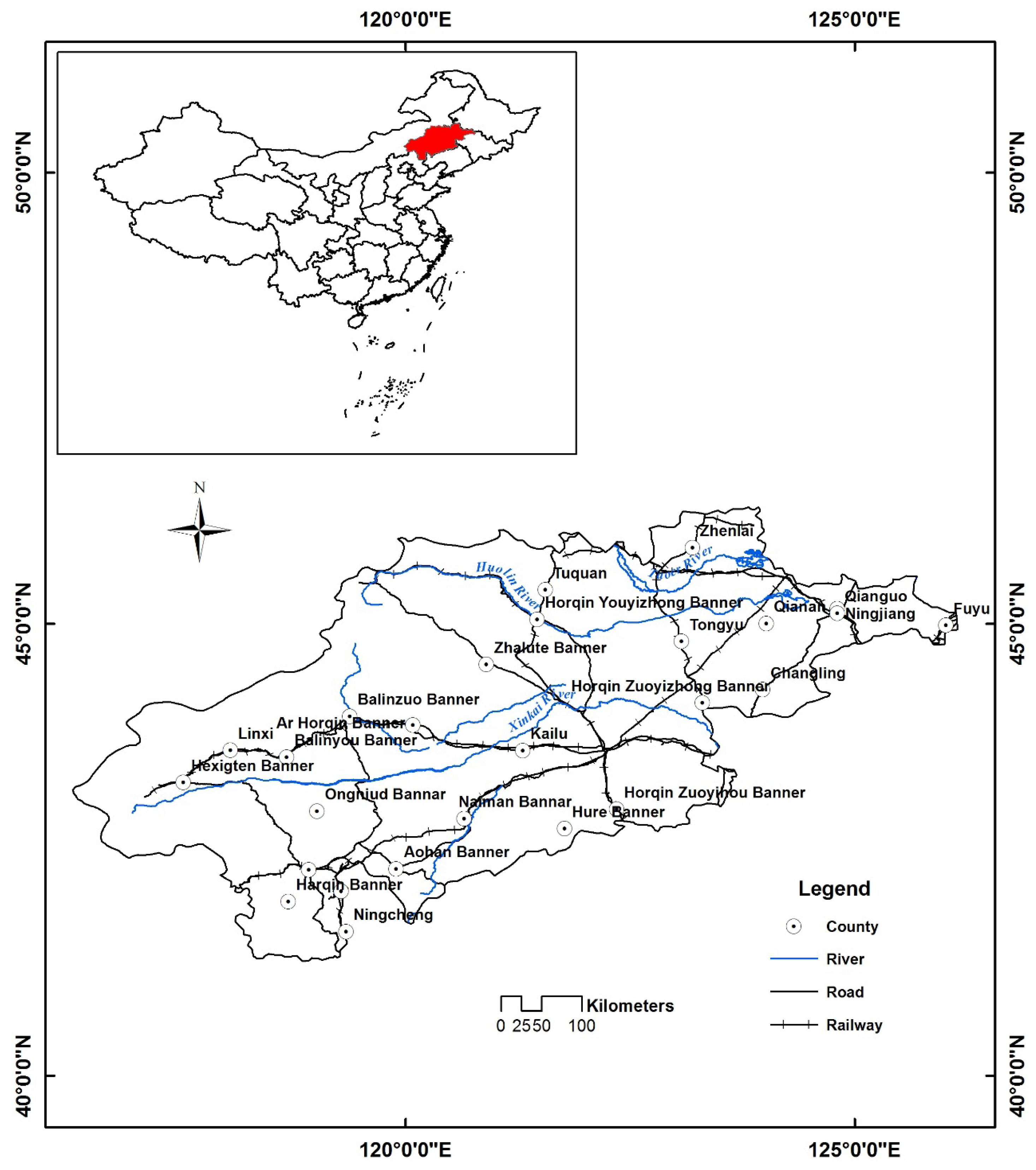
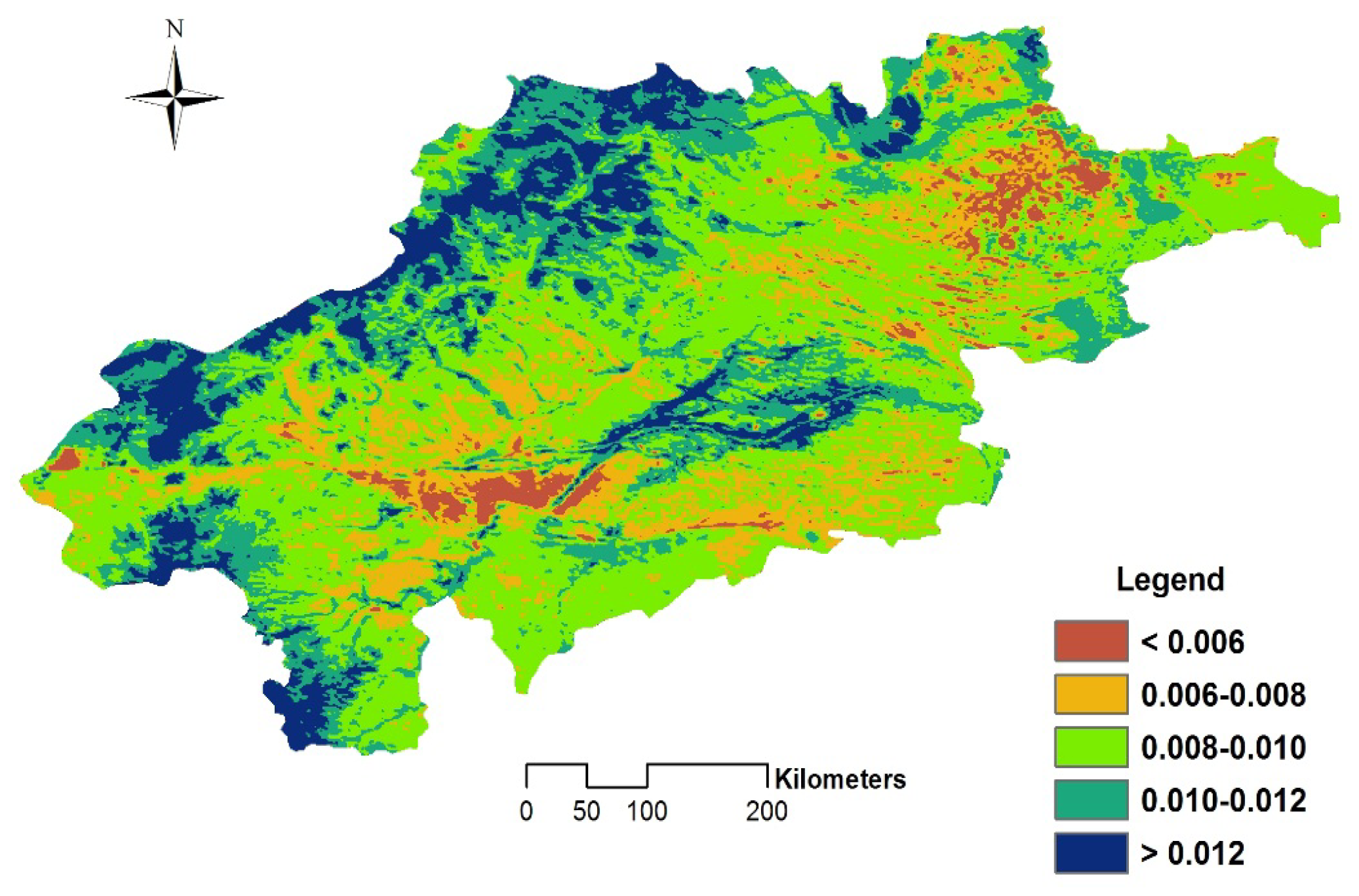
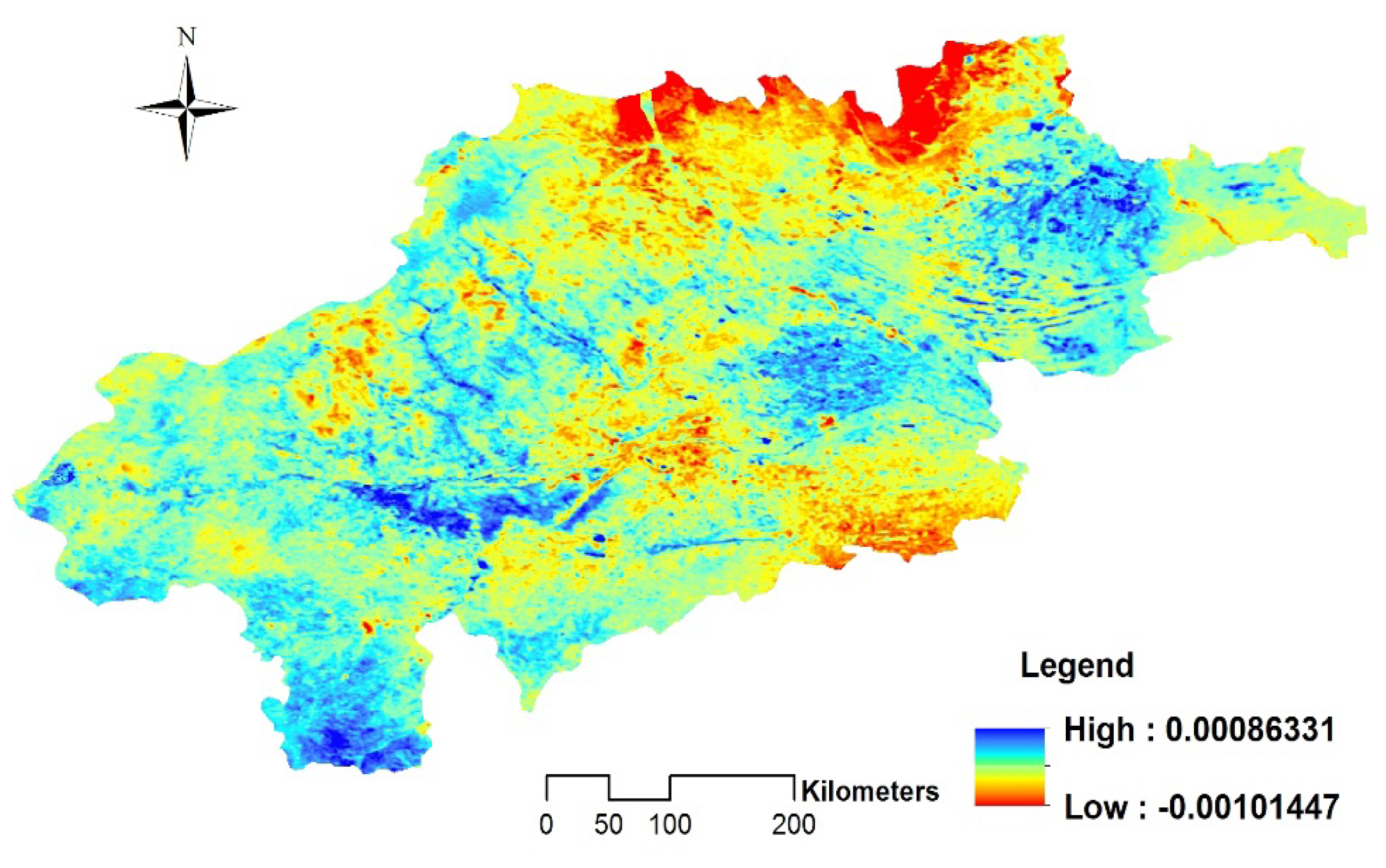
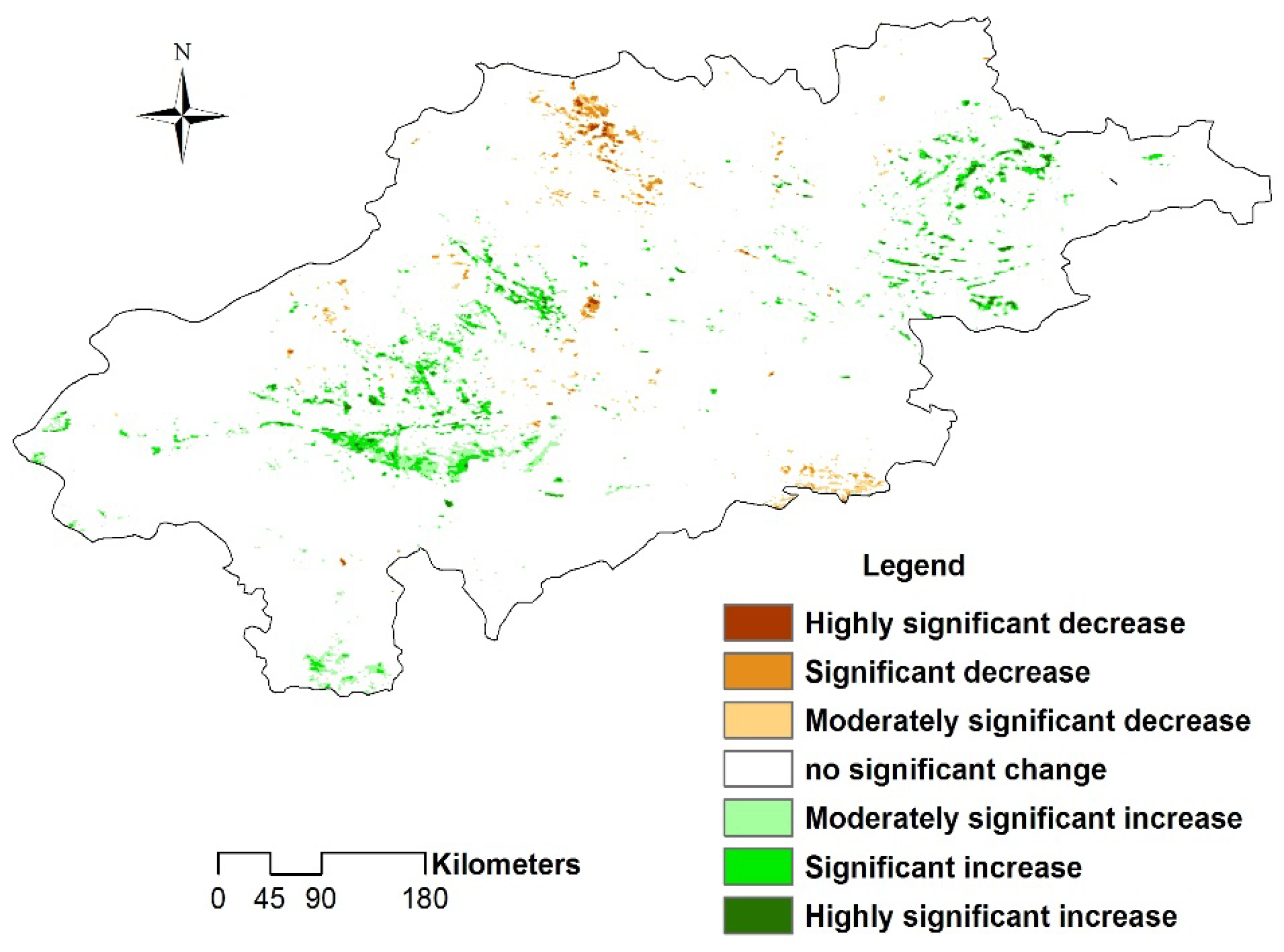

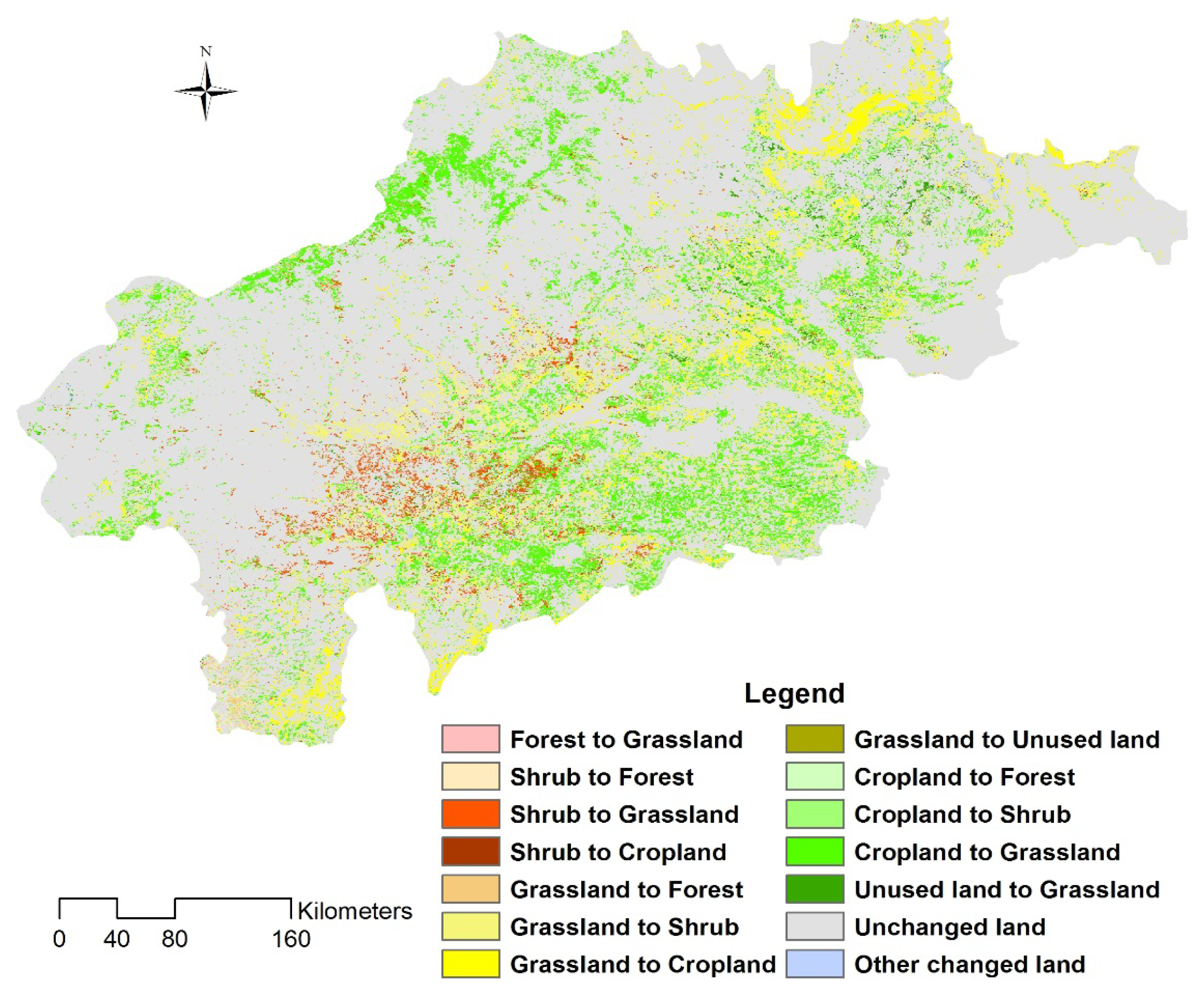
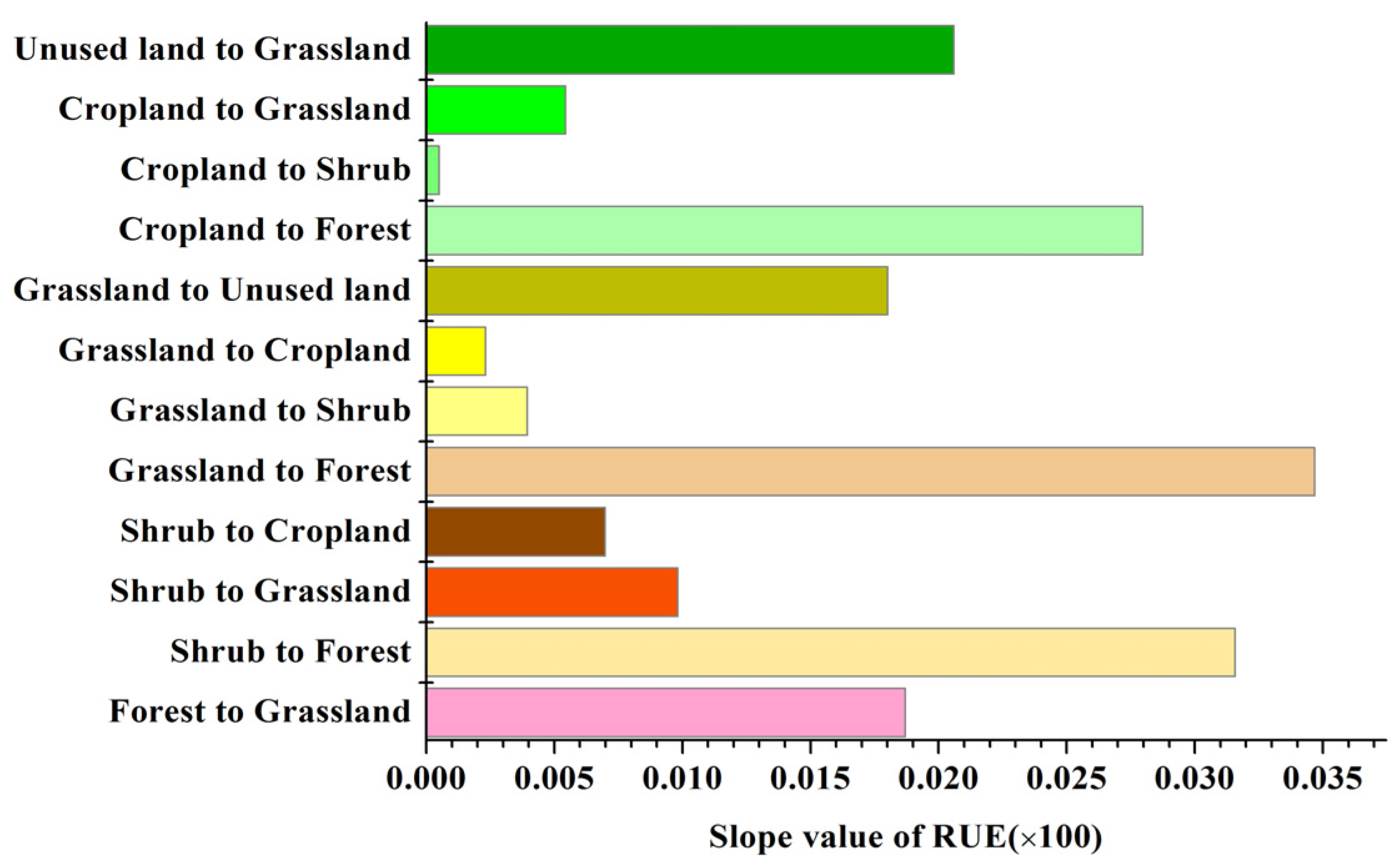

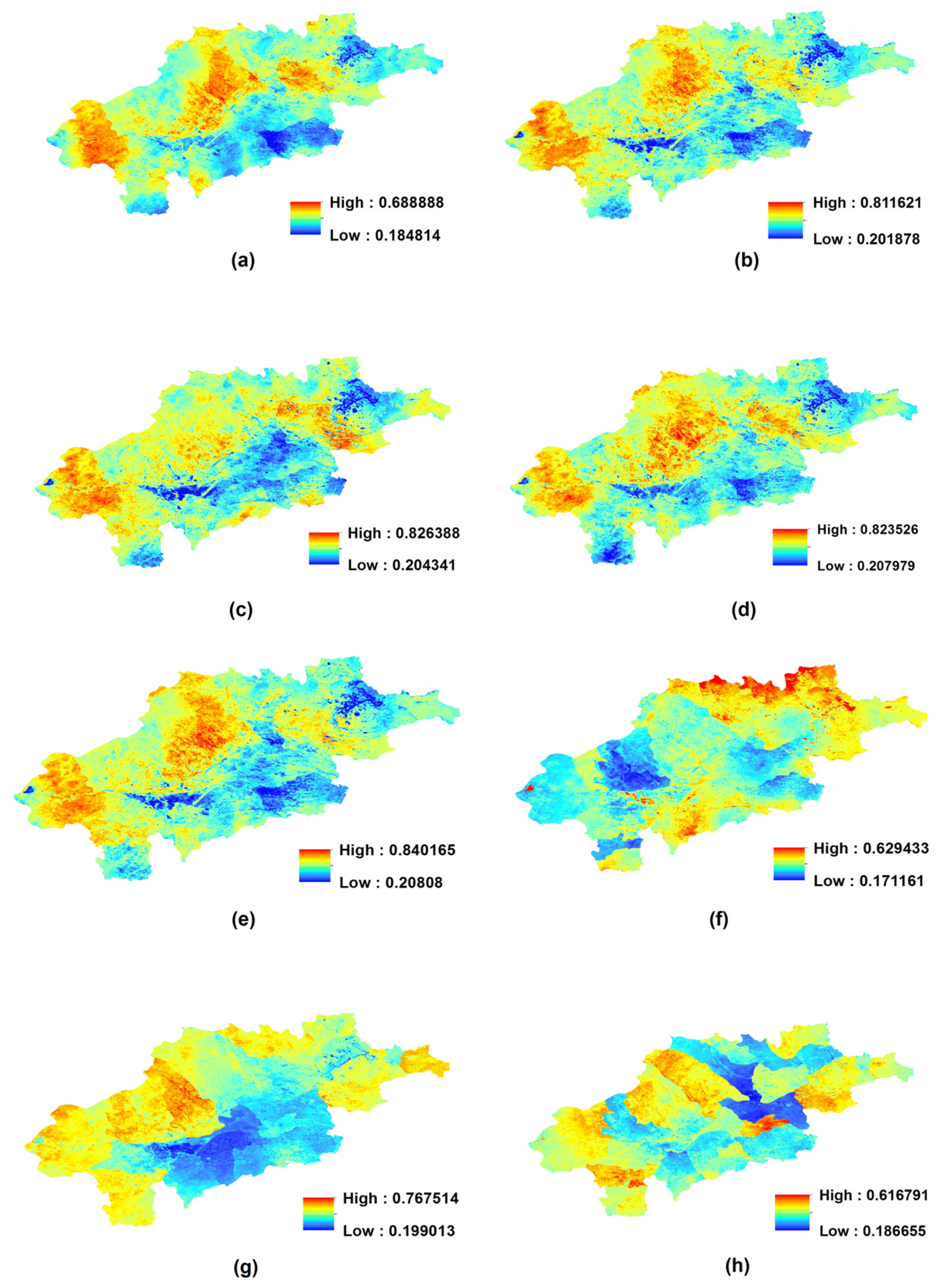
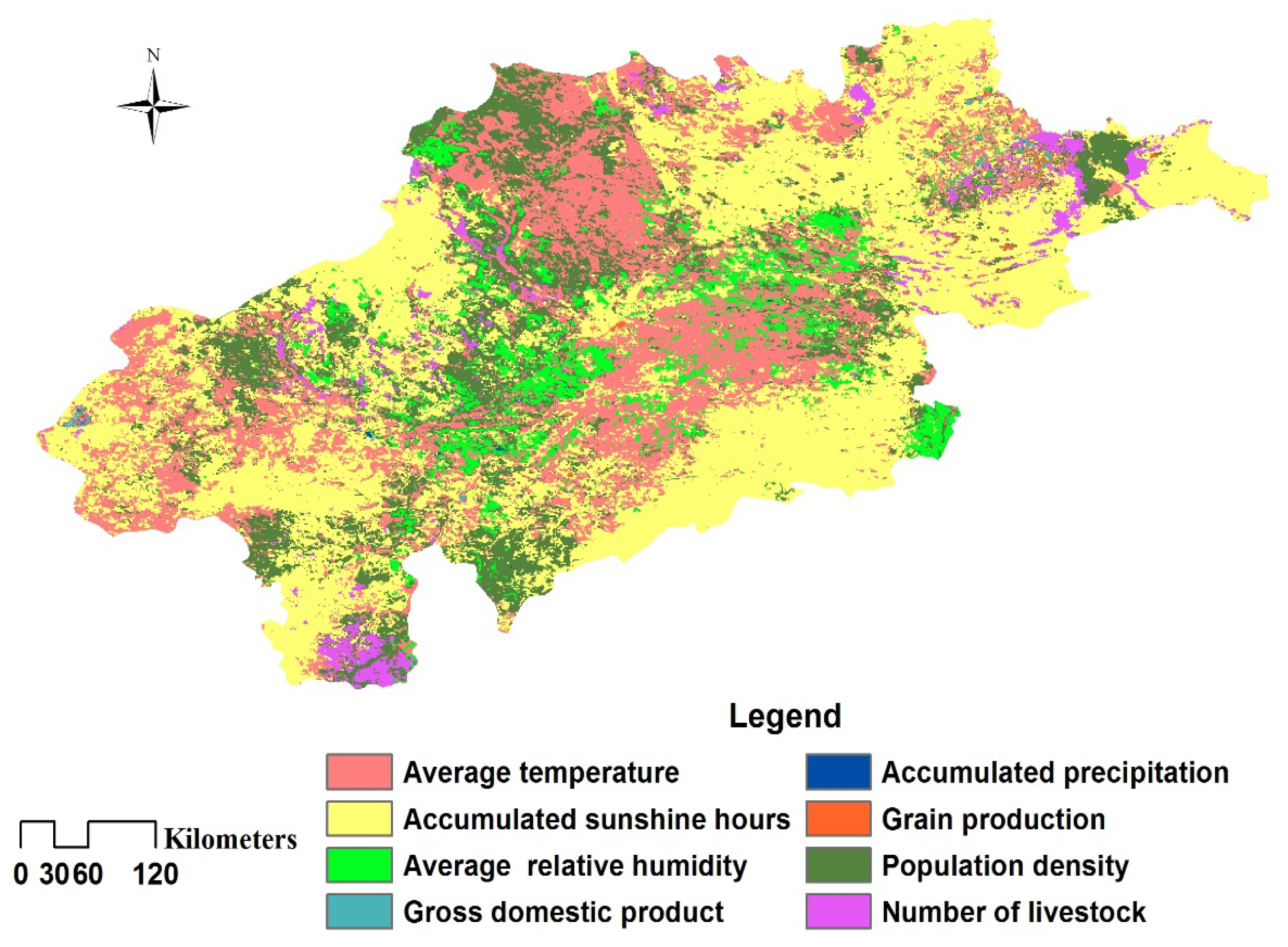
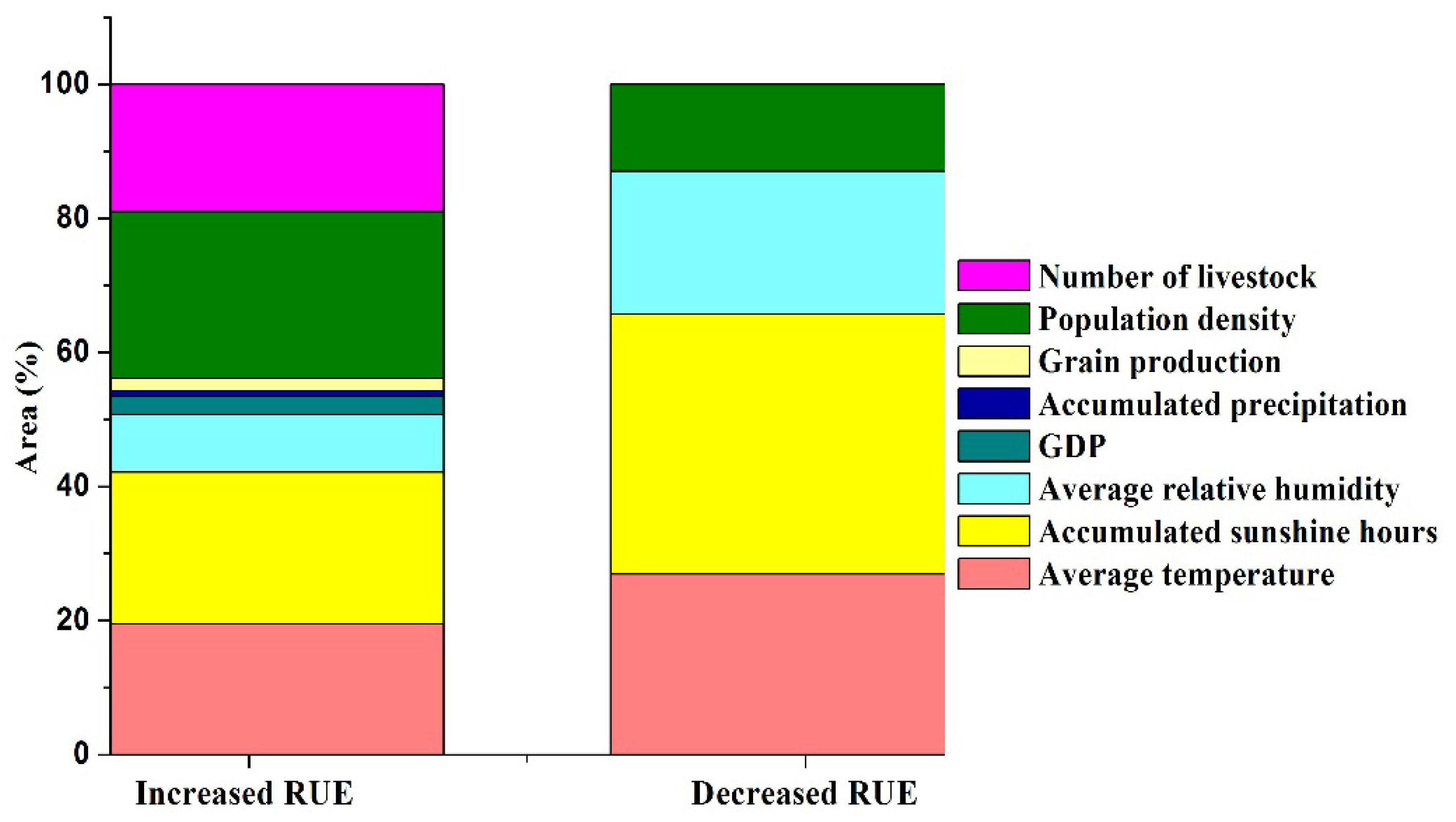
| RUE Change Trend | Significant Level (p) | Area (%) |
|---|---|---|
| Highly significant decrease | SLOPE < 0, p ≤ 0.01 | 0.07 |
| Significant decrease | SLOPE < 0, 0.01 < p ≤ 0.05 | 0.41 |
| Moderately significant decrease | SLOPE < 0, 0.05 < p ≤ 0.1 | 0.81 |
| no significant change | p > 0.1 | 94.47 |
| Moderately significant increase | SLOPE > 0, 0.05 < p ≤ 0.1 | 2.25 |
| Significant increase | SLOPE > 0, 0.01 < p ≤ 0.05 | 1.66 |
| Highly significant increase | SLOPE > 0, p ≤ 0.01 | 0.32 |
© 2016 by the authors; licensee MDPI, Basel, Switzerland. This article is an open access article distributed under the terms and conditions of the Creative Commons by Attribution (CC-BY) license (http://creativecommons.org/licenses/by/4.0/).
Share and Cite
Huang, F.; Xu, S. Spatio-Temporal Variations of Rain-Use Efficiency in the West of Songliao Plain, China. Sustainability 2016, 8, 308. https://doi.org/10.3390/su8040308
Huang F, Xu S. Spatio-Temporal Variations of Rain-Use Efficiency in the West of Songliao Plain, China. Sustainability. 2016; 8(4):308. https://doi.org/10.3390/su8040308
Chicago/Turabian StyleHuang, Fang, and Shuangling Xu. 2016. "Spatio-Temporal Variations of Rain-Use Efficiency in the West of Songliao Plain, China" Sustainability 8, no. 4: 308. https://doi.org/10.3390/su8040308
APA StyleHuang, F., & Xu, S. (2016). Spatio-Temporal Variations of Rain-Use Efficiency in the West of Songliao Plain, China. Sustainability, 8(4), 308. https://doi.org/10.3390/su8040308






